Study of the Effect of Surface Treatment on the Chloride Ion Transport at the Cementitious Spacer–Concrete Interface
Abstract
1. Introduction
2. Materials and Methods
2.1. Materials
- Portland cement CEM II 42.5R was used for all mixes. The density, the specific area, and the water requirement of standard consistency were 2.97 g/cm3, 380 m2/kg, and 25.2%, respectively. The soundness conformed to British standard BS EN 197-1:2011 [20]. The initial and final setting times were 183 min and 275 min, respectively. The 3 day and 28 day flexural strengths were 6.3 MPa and 9.0 MPa, respectively. The 3 day and 28 day compressive strengths were 29.7 MPa and 58.4 MPa, respectively.
- Fly ash was produced from the burning of anthracite or bituminous coal with a density of 2.19 g/cm3. The fineness was 23.6%, classified as category N, and the loss on ignition was 4.84%, classified as category A, conforming to British standard BS EN 450-1:2012 [21]. The water requirement was 98%.
- Ground-granulated blast slag (GGBS) was used. The density and the specific area were 2.82 g/cm3 and 440 m2/kg, respectively. The 7 day and 28 day activity indexes were 87% and 102%, respectively, conforming to British standard BS EN 15167-1:2006 [22].
- Sand with a maximum particle size of 5 mm was used as the fine aggregate. The fineness modulus of sand was 2.3, complying with British standard BS EN 12620:2002+A1:2008 [23] medium grading. The pre-dried particle density was 2754 kg/m3. The loose bulk density and the percentage of voids were 1448 kg/m3 and 47.4%, respectively.
- Two types of gravel (of 5–10 mm particle size and of 10–20 mm particle size) were used as the coarse aggregate (denoted as G5–10 and G10–20, respectively). The pre-dried particle density, the loose bulk density, and the percentage of G5–10 were 2685 kg/m3, 1278 kg/m3, and 52.4%, respectively. The pre-dried particle density, the loose bulk density, and the percentage of G10–20 were 2738 kg/m3, 1451 kg/m3, and 47.0%, respectively. G5–10 and G10–20 were mixed by a 2:3 ratio by mass to comply with the British standard BS EN 12620:2002+A1:2008 [23] overall grading (denoted as G5–20).
- Polycarboxylate superplasticiser produced by Guangdong Jiangmen Qiangli Building Material Technology Co., Ltd., was used. The solid content was 20%.
- A retarder was used as the surface treating agent. The retarder was mainly made of the sodium gluconate retarder for concrete, which had a notable retardation effect. The solid content was 20% and the usage of the retarder for the surface treatment of the spacer was about 0.2~0.3 kg/m2.
- Tap water was used as the batch water.
2.2. Mix Design of Concrete and Spacers
2.3. Preparation of Spacers
- The mixed materials of the chloride-resistant small-size coarse aggregate concrete spacers (SS) and chloride-resistant mortar spacers (MS) were cast into a 40 mm × 40 mm × 160 mm rectangular steel mould and were unmoulded after 24 h;
- The spacers were first cured in water at 20 °C for 3 days and then were exposed to the air at room temperature for 1 day;
- The spacers were cut to the size of 40 mm × 40 mm × 80 mm for the subsequent experiments.
2.4. Surface Treatment of Spacers
2.5. Preparation of Spacers and Concrete Composite Specimen
2.6. Test Methods
3. Results and Discussion
3.1. Compressive Strength
3.2. Resistance to Chloride Penetration
4. Conclusions
- The surface treatment of the spacer had a positive effect on improving the bonding between the spacer and concrete at the interface. The surface treatment technique using retarder to roughen the surface of the spacer can be easily integrated within the current manufacturing process.
- The state-of-practice tests on the hardened concrete can be modified to evaluate the performance of the spacer–concrete composite specimens and provide an estimation of the long-term mechanical and durability properties of the structure at the spacer locations.
- The spacer–concrete composite specimen had a lower compressive strength and a similar resistance to the chloride ion than the control concrete.
- The surface treatment on the spacer improved the compressive strength of the spacer–concrete composite specimen locally, compared to those without surface treatment. The surface-treated spacer exposed a partial aggregate, thereby forming a sufficiently strong interlink at the concrete interface. The failure mode of the composite specimen with surface treatment of the spacer was similar to that of the concrete. However, the composite specimen without the surface treatment of the spacer experienced debonding at the interface when a critical load was applied.
- The surface treatment of the spacer improved the resistance to chloride ions of the composite specimen compared to those without surface treatment. The advantage of surface treatment was partially represented by either the diffusion coefficient DRCM or the column electric flux, as the poor quality at the interface would result in the outlier data that were excluded in the data process.
- The maximum chloride ion penetration depth at the spacer–concrete interface can be used as an additional proxy for the evaluation of the chloride resistance performance of composite specimens. If the maximum penetration depth at the interface is 1.3 times higher than the average penetration depth, the spacer–concrete interface can be identified to have a weak bond and the spacer would require surface treatment to improve the quality of the spacer–concrete interface.
Author Contributions
Funding
Acknowledgments
Conflicts of Interest
References
- Mackey, G.; Januszke, R. Influence of Bar Chairs, Spacers and Blocks on Concrete; Materials Technology Research and Development: Walkley Heights, Australia, 1995; pp. 1–49.
- Alzyoud, S.; Wong, H.S.; Buenfeld, N.R. Influence of reinforcement spacers on mass transport properties and durability of concrete structures. Cem. Concr. Res. 2016, 87, 31–44. [Google Scholar] [CrossRef]
- Danner, T.; Hornbostel, K.; Strømme, Ø.; Geiker, M.R. Self-Healing and Chloride Ingress in Cracked Cathodically Protected Concrete Exposed to Marine Environment for 33 Years; Norwegian University of Science and Technology: Trondheim, Norway, 2019; pp. 1–31. [Google Scholar]
- Kenai, S.; Bahar, R. Evaluation and repair of Algiers new airport building. Cem. Concr. Compos. 2003, 25, 633–641. [Google Scholar] [CrossRef]
- Tang, L.P.; Utgenannt, P. A field study of critical chloride content in reinforced concrete with blended binder. Mater. Corros. 2009, 60, 617–622. [Google Scholar] [CrossRef]
- Angst, U.M.; Geiker, M.R.; Michel, A.; Gehlen, C.; Wong, H.; Isgor, O.B.; Elsener, B.; Hansson, C.M.; François, R.; Hornbostel, K.; et al. The steel–concrete interface. Mater. Struct. 2017, 50, 143. [Google Scholar] [CrossRef]
- Song, H.W.; Lee, C.H.; Ann, K.Y. Factors influencing chloride transport in concrete structures exposed to marine environments. Cem. Concr. Compos. 2008, 30, 113–121. [Google Scholar] [CrossRef]
- Amin, N.U.; Alam, S.; Gul, S. Effect of thermally activated clay on corrosion and chloride resistivity of cement mortar. J. Clean. Prod. 2016, 111, 155–160. [Google Scholar] [CrossRef]
- He, X.; Shi, X. Chloride permeability and microstructure of Portland cement mortars incorporating nanomaterials. Transp. Res. Rec. J. Transp. Res. Board 2008, 2070, 13–21. [Google Scholar] [CrossRef]
- Oh, B.H.; Cha, S.W.; Jang, B.S.; Jang, S.Y. Development of high-performance concrete having high resistance to chloride penetration. Nucl. Eng. Des. 2002, 212, 221–231. [Google Scholar] [CrossRef]
- Cheewaket, T.; Jaturapitakkul, C.; Chalee, W. Concrete durability presented by acceptable chloride level and chloride diffusion coefficient in concrete: 10-year results in marine site. Mater. Struct. 2014, 47, 1501–1511. [Google Scholar] [CrossRef]
- Muslim, F.; Wong, H.S.; Buenfeld, N.R. Improving the Spacer-Concrete Interface for Bond Strength and Durability. In Proceedings of the 6th International Conference on Durability of Concrete Structures (ICDCS 2018), Leeds, UK, 18–20 July 2018. [Google Scholar]
- American Concrete Institute. ACI 315-99: Details and Detailing of Concrete Reinforcement; American Concrete Institute: Farmington Hills, MI, USA, 1999. [Google Scholar]
- American Concrete Institute. ACI SP-66: ACI Detailing Manual; American Concrete Institute: Farmington Hills, MI, USA, 2004. [Google Scholar]
- British Standards Institution. BS 7973-1:2001: Spacers and Chairs for Steel Reinforcement and Their Specification—Part 1: Product Performance Requirements; British Standards Institution: London, UK, 2001. [Google Scholar]
- British Standards Institution. BS 7973-2:2001: Spacers and Chairs for Steel Reinforcement and Their Specification—Part 2: Fixing and Application of Spacers and Chairs and Tying of Reinforcement; British Standards Institution: London, UK, 2001. [Google Scholar]
- Subramanian, N.; Geetha, K. Concrete cover for durable RC structures. Indian Concr. J. 1997, 71, 197–201. [Google Scholar]
- Alzyoud, S. Effect of Reinforcement Spacers on Concrete Microstructure and Durability. Ph.D. Thesis, Imperial College London, London, UK, 2015. [Google Scholar]
- Strømme, Ø. Influence of Cracks on Chloride Diffusion and Reinforcement Corrosion in Concrete. Master’s Thesis, Norwegian University of Science and Technology, Trondheim, Norway, 2017. [Google Scholar]
- British Standards Institution. BS EN 197-1:2011: Cement—Part 1: Composition, Specifications and Conformity Criteria for Common Cements; British Standards Institution: London, UK, 2011. [Google Scholar]
- British Standards Institution. BS EN 450-1:2012: Fly Ash for Concrete—Part 1: Definition, Specifications and Conformity Criteria; British Standards Institution: London, UK, 2012. [Google Scholar]
- British Standards Institution. BS EN 450-1:2006: Ground Granulated Blast Furnace Slag for Use in Concrete, Mortar and Grout—Part 1: Definitions, Specifications and Conformity Criteria; British Standards Institution: London, UK, 2006. [Google Scholar]
- British Standards Institution. BS EN 12620:2002+A1:2008: Aggregates for Concrete; British Standards Institution: London, UK, 2002. [Google Scholar]
- Lee, T.; Lee, J. Evaluation of Chloride Resistance of Early-Strength Concrete Using Blended Binder and Polycarboxylate-Based Chemical Admixture. Appl. Sci. 2020, 10, 2972. [Google Scholar] [CrossRef]
- British Standards Institution. BS EN 12390-1:2012: Testing Hardened Concrete—Part 1: Shape, Dimensions and Other Requirements for Specimens and Moulds; British Standards Institution: London, UK, 2012. [Google Scholar]
- British Standards Institution. BS EN 12390-6:2009: Testing Hardened Concrete—Part 6: Tensile Splitting Strength of Test Specimens; British Standards Institution: London, UK, 2009. [Google Scholar]
- China Ministry of Housing and Urban-Rural Development. GB/T 50081-2019: Standard for Test Methods of Concrete Physical and Mechanical Properties; China Ministry of Housing and Urban-Rural Development: Beijing, China, 2019.
- China Ministry of Housing and Urban-Rural Development. GB/T 50082-2009: Standard for Test Methods of Long-Term Performance and Durability of Ordinary Concrete; China Ministry of Housing and Urban-Rural Development: Beijing, China, 2009.
- Nordtest. NT BUILD 492: Concrete, Mortar and Cement-Based Repair Materials: Chloride Migration Coefficient from Non-Steady-State Migration Experiments; Nordtest: Espoo, Finland, 1999. [Google Scholar]
- American Society for Testing and Materials. ASTM C1202: Standard Test Method for Electrical Indication of Concrete’s Ability to Resist Chloride Ion Penetration; American Society for Testing and Materials: West Conshohocken, PA, USA, 2019. [Google Scholar]
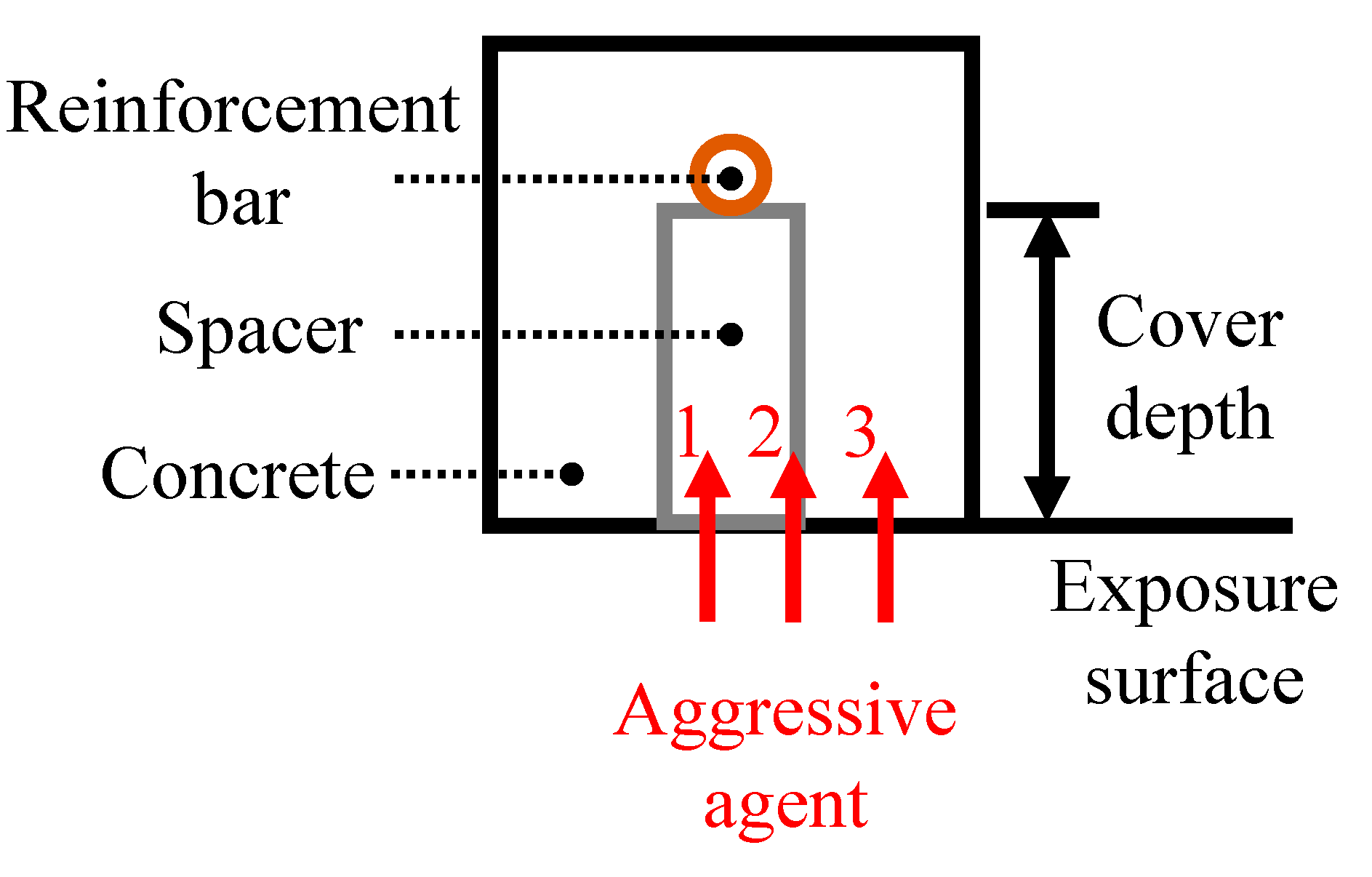


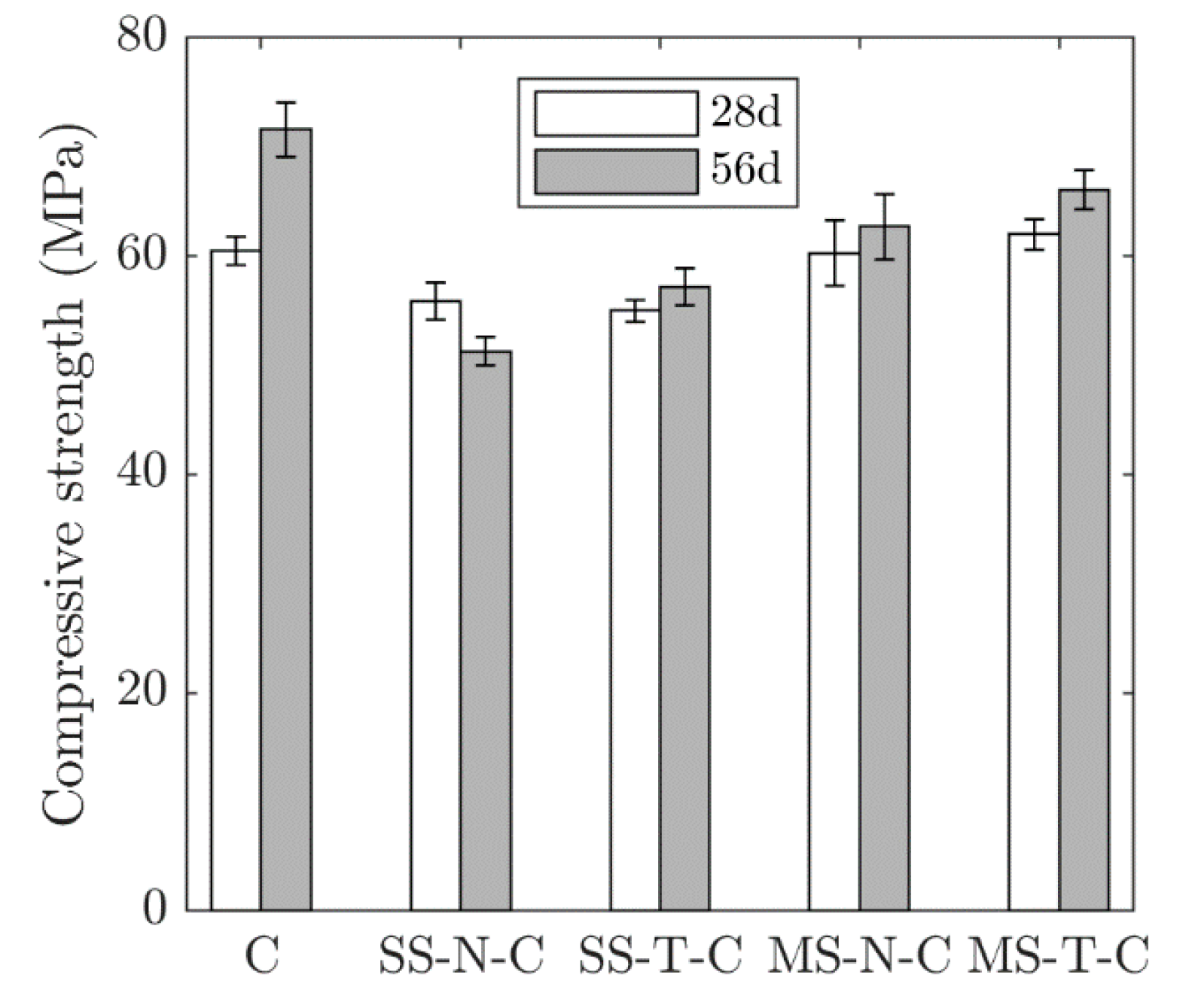
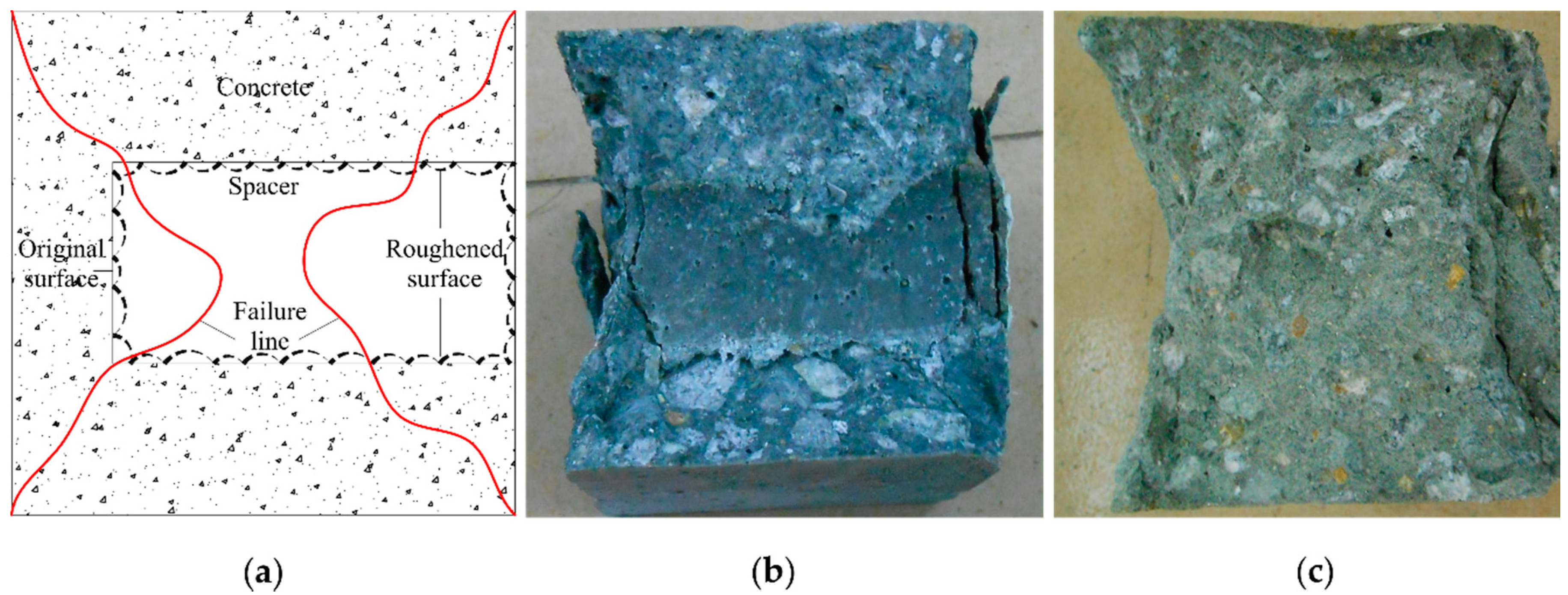
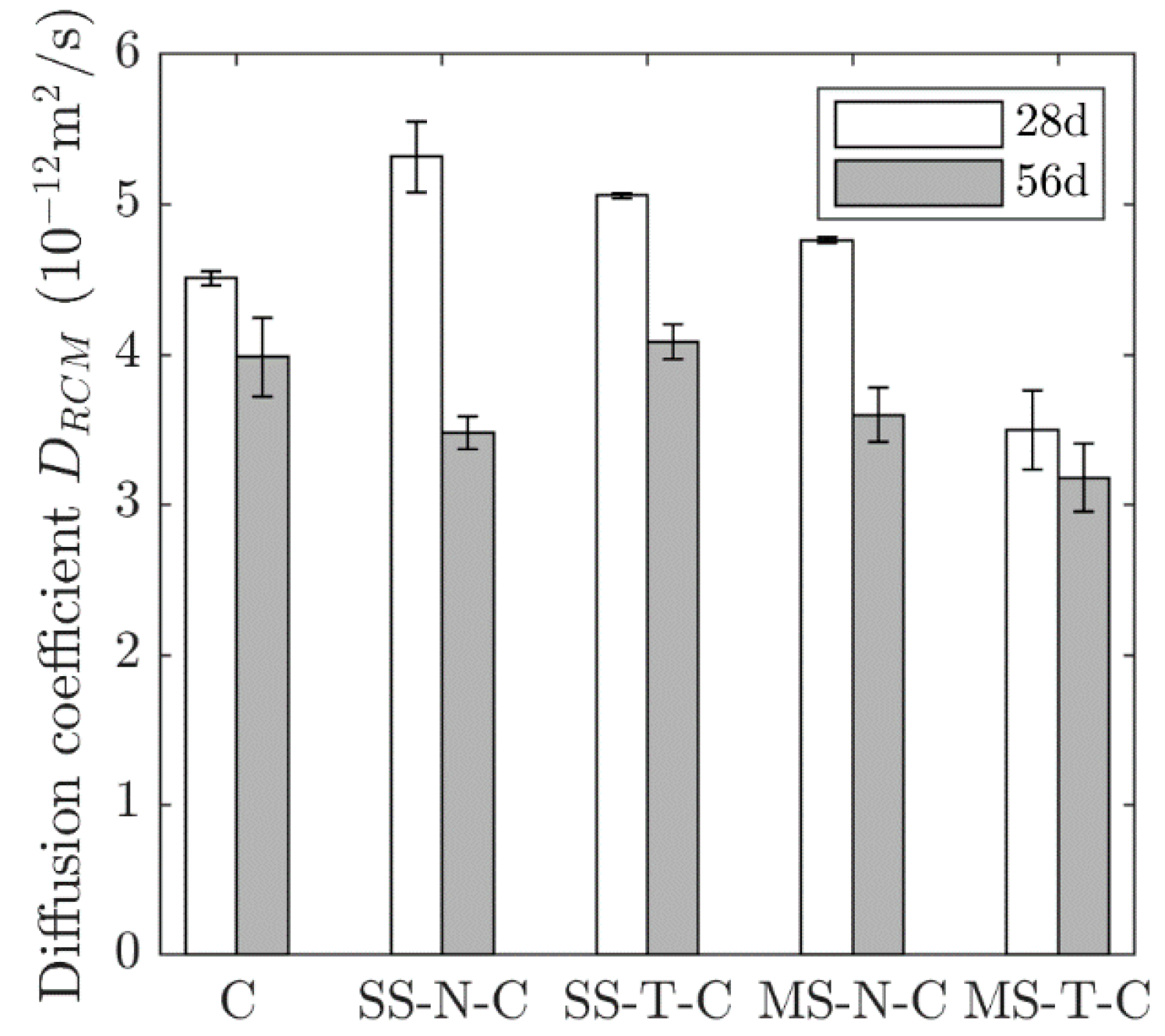
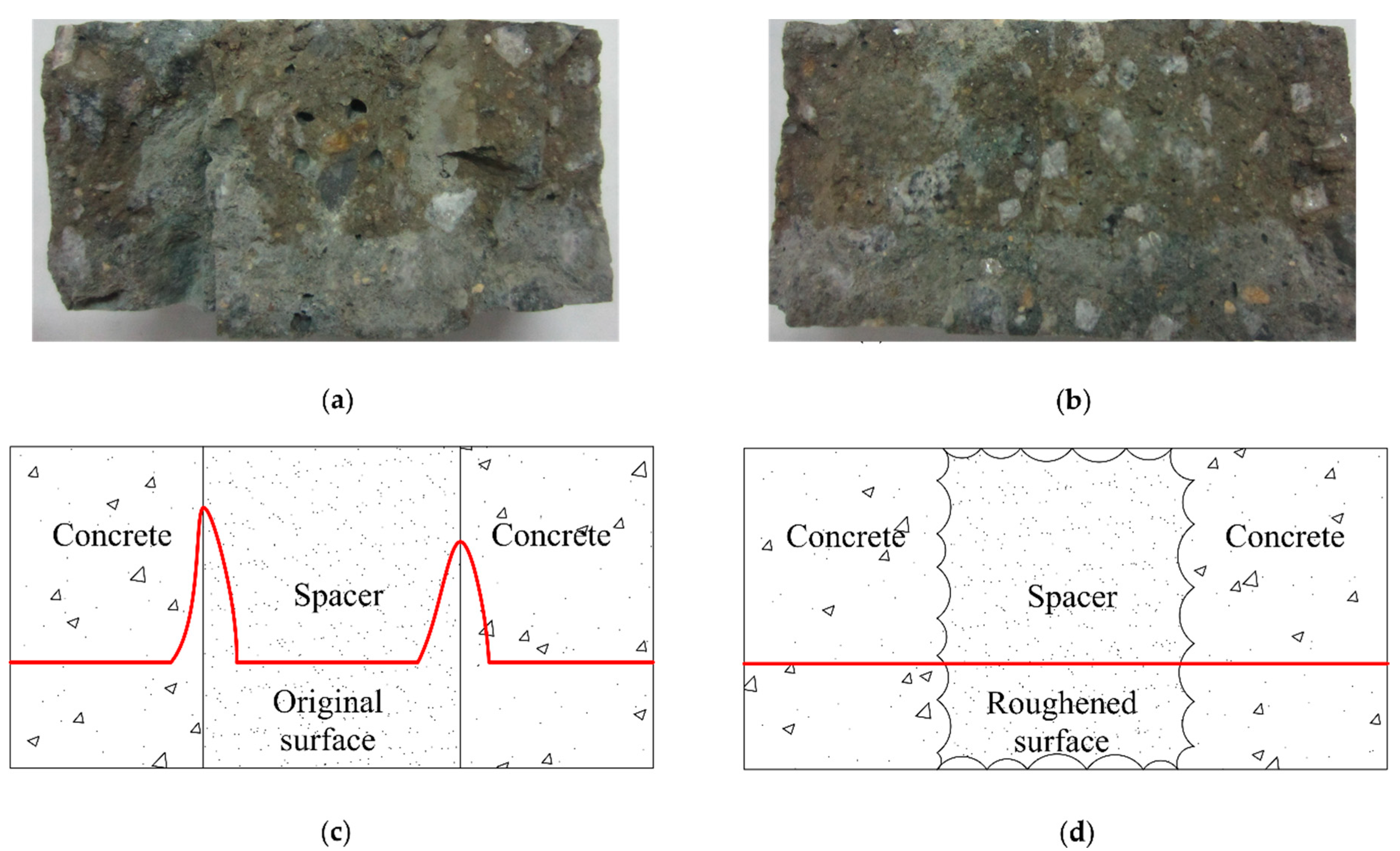

| Mix ID | W/B | Total Binder (kg/m3) | GGBS Dosage (%) | Fly Ash Dosage (%) | Superplasticiser (%) | Sand Ratio (%) |
|---|---|---|---|---|---|---|
| C * | 0.35 | 430 | 50 | 15 | 1.5 | 40 |
| SS + | 0.36 | 500 | 33 | 27 | 1.2 | 50 |
| MS | 0.36 | 625 | 33 | 27 | 1.2 | 100 |
© 2020 by the authors. Licensee MDPI, Basel, Switzerland. This article is an open access article distributed under the terms and conditions of the Creative Commons Attribution (CC BY) license (http://creativecommons.org/licenses/by/4.0/).
Share and Cite
Yang, Y.; Huang, C.; Guo, W.; Zhao, H.; Li, Z.; Li, J.; Bao, J.; Wang, H. Study of the Effect of Surface Treatment on the Chloride Ion Transport at the Cementitious Spacer–Concrete Interface. Appl. Sci. 2020, 10, 5196. https://doi.org/10.3390/app10155196
Yang Y, Huang C, Guo W, Zhao H, Li Z, Li J, Bao J, Wang H. Study of the Effect of Surface Treatment on the Chloride Ion Transport at the Cementitious Spacer–Concrete Interface. Applied Sciences. 2020; 10(15):5196. https://doi.org/10.3390/app10155196
Chicago/Turabian StyleYang, Yibo, Chen Huang, Wenying Guo, Hui Zhao, Zhenjie Li, Jiankuan Li, Jianyong Bao, and Hengchang Wang. 2020. "Study of the Effect of Surface Treatment on the Chloride Ion Transport at the Cementitious Spacer–Concrete Interface" Applied Sciences 10, no. 15: 5196. https://doi.org/10.3390/app10155196
APA StyleYang, Y., Huang, C., Guo, W., Zhao, H., Li, Z., Li, J., Bao, J., & Wang, H. (2020). Study of the Effect of Surface Treatment on the Chloride Ion Transport at the Cementitious Spacer–Concrete Interface. Applied Sciences, 10(15), 5196. https://doi.org/10.3390/app10155196




